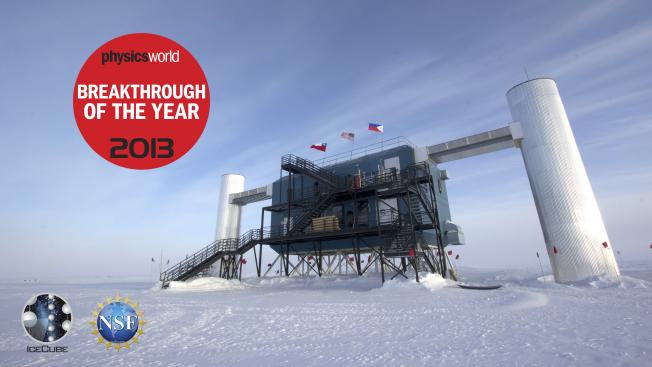The high energy neutrino cross-section in the Standard Model and its uncertainty
ArXiv 1106.3723 (2011)
Abstract:
Updated predictions are presented for high energy neutrino and antineutrino charged and neutral current cross-sections within the conventional DGLAP formalism of NLO QCD using modern PDF fits. PDF uncertainties from model assumptions and parametrization bias are considered in addition to the experimental uncertainties. Particular attention is paid to assumptions and biases which could signal the need for extension of the conventional formalism to include effects such as ln(1/x) resummation or non-linear effects of high gluon density.Neutrino analysis of the September 2010 Crab Nebula flare and time-integrated constraints on neutrino emission from the Crab using IceCube
ArXiv 1106.3484 (2011)
Abstract:
We present the results for a search of high-energy muon neutrinos with the IceCube detector in coincidence with the Crab nebula flare reported on September 2010 by various experiments. Due to the unusual flaring state of the otherwise steady source we performed a prompt analysis of the 79-string configuration data to search for neutrinos that might be emitted along with the observed gamma-rays. We performed two different and complementary data selections of neutrino events in the time window of 10 days around the flare. One event selection is optimized for discovery of E^-2 neutrino spectrum typical of 1st order Fermi acceleration. A similar event selection has also been applied to the 40-string data to derive the time-integrated limits to the neutrino emission from the Crab. The other event selection was optimized for discovery of neutrino spectra with softer spectral index and TeV energy cut-offs as observed for various galactic sources in gamma-rays. The 90% CL best upper limits on the Crab flux during the 10 day flare are 4.73 x 10^-11 cm-2 s-1 TeV-1 for an E^-2 neutrino spectrum and 2.50 x 10^-10 cm-2 s-1 TeV-1 for a softer neutrino spectra of E-2.7, as indicated by Fermi measurements during the flare. IceCube has also set a time-integrated limit on the neutrino emission of the Crab using 375.5 days of livetime of the 40-string configuration data. This limit is compared to existing models of neutrino production from the Crab and its impact on astrophysical parameters is discussed. The most optimistic predictions of some models are already rejected by the IceCube neutrino telescope with more than 90% CL.Anisotropy and chemical composition of ultra-high energy cosmic rays using arrival directions measured by the Pierre Auger Observatory
ArXiv 1106.3048 (2011)
Abstract:
The Pierre Auger Collaboration has reported evidence for anisotropy in the distribution of arrival directions of the cosmic rays with energies $E>E_{th}=5.5\times 10^{19}$ eV. These show a correlation with the distribution of nearby extragalactic objects, including an apparent excess around the direction of Centaurus A. If the particles responsible for these excesses at $E>E_{th}$ are heavy nuclei with charge $Z$, the proton component of the sources should lead to excesses in the same regions at energies $E/Z$. We here report the lack of anisotropies in these directions at energies above $E_{th}/Z$ (for illustrative values of $Z=6,\ 13,\ 26$). If the anisotropies above $E_{th}$ are due to nuclei with charge $Z$, and under reasonable assumptions about the acceleration process, these observations imply stringent constraints on the allowed proton fraction at the lower energies.Observation of Anisotropy in the Arrival Directions of Galactic Cosmic Rays at Multiple Angular Scales with IceCube
ArXiv 1105.2326 (2011)
Abstract:
Between May 2009 and May 2010, the IceCube neutrino detector at the South Pole recorded 32 billion muons generated in air showers produced by cosmic rays with a median energy of 20 TeV. With a data set of this size, it is possible to probe the southern sky for per-mille anisotropy on all angular scales in the arrival direction distribution of cosmic rays. Applying a power spectrum analysis to the relative intensity map of the cosmic ray flux in the southern hemisphere, we show that the arrival direction distribution is not isotropic, but shows significant structure on several angular scales. In addition to previously reported large-scale structure in the form of a strong dipole and quadrupole, the data show small-scale structure on scales between 15 degrees and 30 degrees. The skymap exhibits several localized regions of significant excess and deficit in cosmic ray intensity. The relative intensity of the smaller-scale structures is about a factor of 5 weaker than that of the dipole and quadrupole structure. The most significant structure, an excess localized at right ascension 122.4 degrees and declination -47.4 degrees, extends over at least 20 degrees in right ascension and has a post-trials significance of 5.3 sigma. The origin of this anisotropy is still unknown.A Search for a Diffuse Flux of Astrophysical Muon Neutrinos with the IceCube 40-String Detector
ArXiv 1104.5187 (2011)



